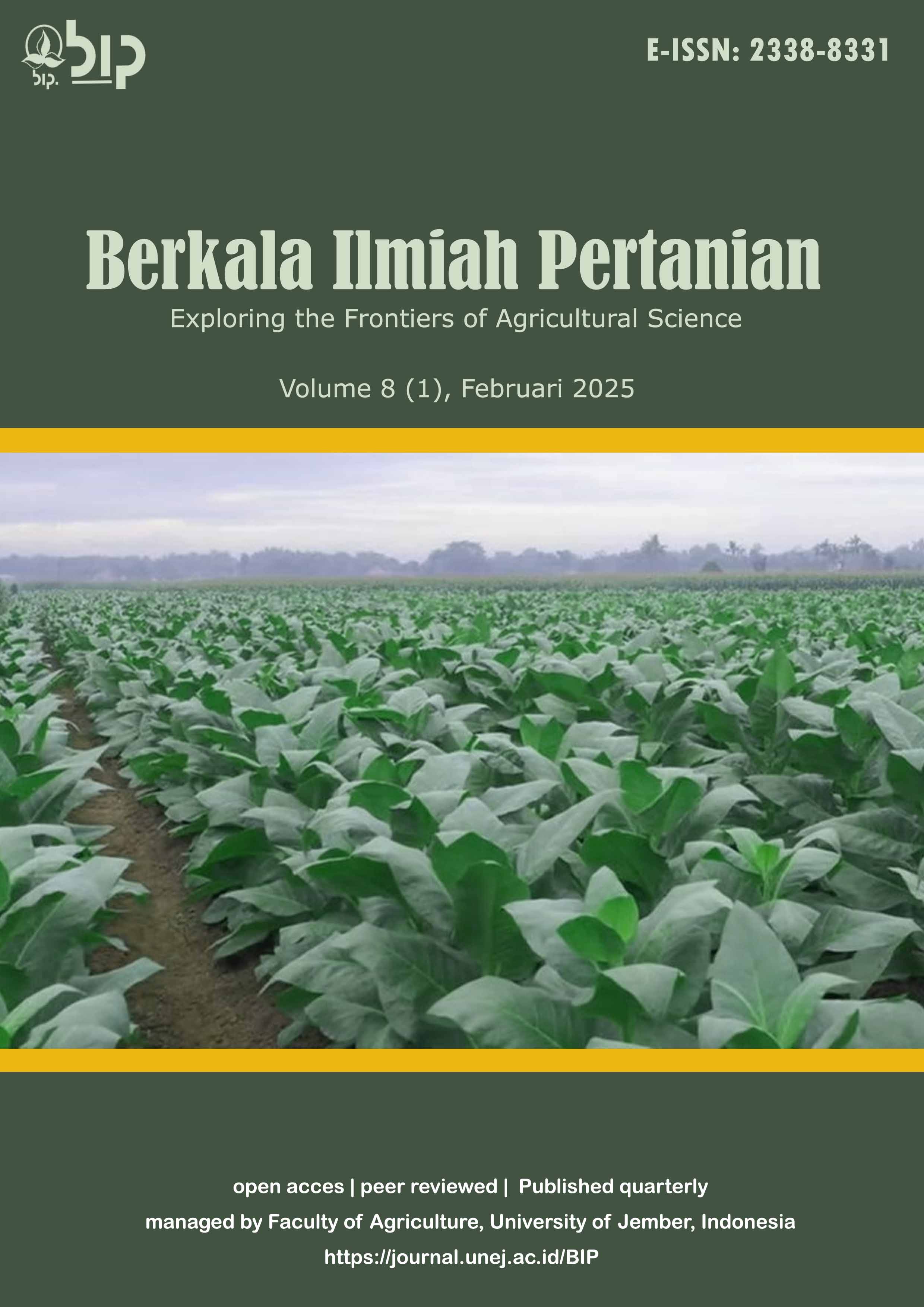Transformasi Mineral Klei pada Pertanian Intensif: Implikasi terhadap Kesuburan Tanah dan Keberlanjutan
DOI:
https://doi.org/10.19184/bip.v8i1.53699Keywords:
Intensifikasi pertanian, keberlanjutan, mineral klei, transformasi kleiAbstract
Transformasi mineral klei dalam tanah akibat intensifikasi pertanian memiliki dampak signifikan
terhadap kesuburan tanah dan keberlanjutan sistem pertanian. Artikel review ini mengkaji dinamika
transformasi mineral klei yang dipicu oleh praktik seperti pemupukan kimia, irigasi berlebih, dan
pengolahan tanah intensif. Transformasi ini memengaruhi kapasitas tukar kation, retensi hara, dan
stabilitas agregat tanah, dengan implikasi jangka panjang terhadap produktivitas dan kesehatan tanah.
Kajian literatur dilakukan dengan meninjau publikasi dalam lima tahun terakhir yang berkaitan dengan
kata kunci "transformasi mineral klei," "evolusi klei pada tanah," dan "pengelolaan tanah pertanian
berkelanjutan." Sumber yang dipilih berasal dari basis data ilmiah terkemuka dan mencakup studi yang
secara representatif menggambarkan transformasi mineral klei dalam sistem tanah pertanian serta
dampaknya terhadap sifat tanah. Hasil kajian menunjukkan bahwa interaksi antara mineral klei, bahan
organik, dan mikroorganisme dapat mempercepat transformasi mineral, tetapi juga membuka peluang
untuk pengelolaan adaptif yang meningkatkan fungsi tanah. Oleh karena itu, strategi pertanian
berkelanjutan berbasis bukti, seperti penggunaan biochar dan pertanian presisi, direkomendasikan
untuk memitigasi dampak negatif transformasi mineral klei dan mendukung keberlanjutan tanah.
Downloads
References
Akinbodunse, S. J., Ufer, K., Dohrmann, R., & Mikutta, C. 2024. Evaluation of the Rietveld method for
determining content and chemical composition of inorganic X-ray amorphous materials in soils.
American Mineralogist, 109(12), 2037–2051. https://doi.org/10.2138/am-2023-9240
Austin, J. C., Perry, A., Richter, D. D., & Schroeder, P. A. 2018. Modifications of 2:1 Clay Minerals in a
Kaolinite-Dominated Ultisol under Changing Land-Use Regimes. Clays and Clay Minerals, 66(1), 61–
73. https://doi.org/10.1346/CCMN.2017.064085
Benavides, P. A. D., & Guggenheim, S. 2024. Effect of Layer Charge Density and Charge Location on the
Swelling of Smectite: Implications for Geological Storage of CO2 and High-Level Nuclear Wastes.
American Mineralogist. https://doi.org/10.2138/am-2024-9557
Bezboruah, M., Sharma, S. K., Laxman, T., Ramesh, S., Sampathkumar, T., Gulaiya, S., Malathi, G., &
Krishnaveni, S. A. 2024. Conservation Tillage Practices and Their Role in Sustainable Farming
Systems. Journal of Experimental Agriculture International, 46(9), 946–959.
https://doi.org/10.9734/jeai/2024/v46i92892
Chen, M., Zhang, S., Liu, L., & Ding, X. 2023. Influence of organic fertilization on clay mineral transformation
and soil phosphorous retention: Evidence from an 8-year fertilization experiment. Soil and Tillage
Research, 230, 105702. https://doi.org/10.1016/j.still.2023.105702
Das, D., Sahoo, J., Raza, M. B., Barman, M., & Das, R. 2022. Ongoing soil potassium depletion under intensive
cropping in India and probable mitigation strategies. A review. Agronomy for Sustainable
Development, 42(1), 4. https://doi.org/10.1007/s13593-021-00728-6
Datta, S., Ghosh, S., & Das, D. 2020. Soil Mineralogy and Clay Minerals. In The Soils of India (pp. 131–149).
Springer International Publishing. https://doi.org/10.1007/978-3-030-31082-0
Elhassan, A. A. M., Mnzool, M., Smaoui, H., Jendoubi, A., Elnaim, B. M. E., & Faihan Alotaibi, M. 2023. Effect
of clay mineral content on soil strength parameters. Alexandria Engineering Journal, 63, 475–485.
https://doi.org/10.1016/j.aej.2022.08.012
Fernandez-Marcos, M. L., Macías, F., & Guitián-Ojea, F. 1979. A contribution to the study of the stability of
clay minerals from the soil solution composition at different pF values. Clay Minerals, 14(1), 29–37.
https://doi.org/10.1180/claymin.1979.014.1.04
Firmano, R. F., Melo, V. F., Montes, C. R., De Oliveira, A., De Castro, C., & Alleoni, L. R. F. 2020. Potassium
Reserves in the Clay Fraction of a Tropical Soil Fertilized for Three Decades. Clays and Clay Minerals,
68(3), 237–249. https://doi.org/10.1007/s42860-020-00078-6
Futa, B., Gmitrowicz-Iwan, J., Skersienė, A., Šlepetienė, A., & Parašotas, I. 2024. Innovative Soil Management
Strategies for Sustainable Agriculture. Sustainability, 16(21), 9481.
https://doi.org/10.3390/su16219481
Gao, Y., Gao, Y., Ibarra, D. E., Du, X., Dong, T., Liu, Z., & Wang, C. 2021. Clay mineralogical evidence for mid-
latitude terrestrial climate change from the latest Cretaceous through the earliest Paleogene in the
Songliao Basin, NE China. Cretaceous Research, 124, 104827.
https://doi.org/10.1016/j.cretres.2021.104827
Günal, H., & Acir, N. 2024. Spatial variability of clay minerals in a semi-arid region of Turkiye. GeodermaRegional, 38, e00820. https://doi.org/10.1016/j.geodrs.2024.e00820
Gverić, Z., Rubinić, V., Kampić, Š., Vrbanec, P., Paradžik, A., & Tomašić, N. 2022. Clay mineralogy of soils
developed from Miocene marls of Medvednica Mt., NW Croatia: Origin and transformation in
temperate climate. CATENA, 216, 106439. https://doi.org/10.1016/j.catena.2022.106439
H. Esaa, F., & Kassim, J. K. 2021. Identification and distribution of minerals in soils from al-Ahrar area, Waist
province, Iraq. Journal of Life Science and Applied Research, 2(1), 16–23.
https://doi.org/10.59807/jlsar.v2i1.26
Ható, Z., Makó, É., & Kristóf, T. 2013. Molecular simulation study of kaolinite intercalation. 41, 2013.
Herrero, J., Jiménez-Ballesta, R., & Castañeda, C. 2024. The Clay Minerals in the Soils of the Gypseous Belt
of Barbastro, NE Spain. Land, 13(9), 1415. https://doi.org/10.3390/land13091415
Hong, H., Ji, K., Hei, H., Wang, C., Liu, C., Zhao, L., Lanson, B., Zhao, C., Fang, Q., & Algeo, T. J. 2023. Clay
mineral evolution and formation of intermediate phases during pedogenesis on picrite basalt bedrock
under temperate conditions (Yunnan, southwestern China). CATENA, 220, 106677.
https://doi.org/10.1016/j.catena.2022.106677
Huang, P. M. 2010. Impacts of Mineral Colloids on the Transformation of Biomolecules and Physical and
Chemical Protection of Soil Organic Carbon. In J. Xu & P. M. Huang (Eds.), Molecular Environmental
Soil Science at the Interfaces in the Earth’s Critical Zone (pp. 13–16). Springer Berlin Heidelberg.
https://doi.org/10.1007/978-3-642-05297-2_4
Ibarra, D. E., & Evaristo, J. 2024. Soil pore water evaporation and temperature influences on clay mineral
paleothermometry. Communications Earth & Environment, 5(1), 21. https://doi.org/10.1038/s43247-
024-01201-4
Karathanasis, A. D., & Hajek, B. F. 1983. Transformation of Smectite to Kaolinite in Naturally Acid Soil
Systems: Structural and Thermodynamic Considerations. Soil Science Society of America Journal,
47(1), 158–163. https://doi.org/10.2136/sssaj1983.03615995004700010031x
Keller, C., Rizwan, M., & Meunier, J.-D. 2021. Are Clay Minerals a Significant Source of Si for Crops? A
Comparison of Amorphous Silica and the Roles of the Mineral Type and pH. Silicon, 13(10), 3611–
3618. https://doi.org/10.1007/s12633-020-00877-5
Kome, G. K., Enang, R. K., Tabi, F. O., & Yerima, B. P. K. 2019. Influence of Clay Minerals on Some Soil
Fertility Attributes: A Review. Open Journal of Soil Science, 09(09), 155–188.
https://doi.org/10.4236/ojss.2019.99010
Li, H., Hu, Z., Wan, Q., Mu, B., Li, G., & Yang, Y. 2022. Integrated Application of Inorganic and Organic
Fertilizer Enhances Soil Organo-Mineral Associations and Nutrients in Tea Garden Soil. Agronomy,
12(6), 1330. https://doi.org/10.3390/agronomy12061330
Li, S., Chen, S., Bai, S., Tan, J., & Jiang, X. 2024. Intensive agricultural management-induced subsurface
accumulation of water-extractable colloidal P in a Vertisol. SOIL, 10(1), 49–59.
https://doi.org/10.5194/soil-10-49-2024
Li, S., He, H., Tao, Q., Zhu, J., Tan, W., Ji, S., Yang, Y., & Zhang, C. 2020. Kaolinization of 2:1 type clay
minerals with different swelling properties. American Mineralogist, 105(5), 687–696.
https://doi.org/10.2138/am-2020-7339
Liao, Q., Gu, H., Qi, C., Chao, J., Zuo, W., Liu, J., Chen, T., & Zhang, L. 2024. Mapping global distributions of
clay-size minerals via soil properties and machine learning techniques. Science of The Total
Environment, 949, 174776. https://doi.org/10.1016/j.scitotenv.2024.174776
Lin, Y., Wang, J., & Lin, C. 2021. Response of toxic metal distributions and sources to anthropogenic activities
and pedogenic processes in the Albic Luvisol profile of northeastern China. Environmental Advances,
6, 100142. https://doi.org/10.1016/j.envadv.2021.100142
Liu, Y.-L., Yao, S.-H., Han, X.-Z., Zhang, B., & Banwart, S. A. 2017. Soil Mineralogy Changes With Different
Agricultural Practices During 8-Year Soil Development From the Parent Material of a Mollisol. In
Advances in Agronomy (Vol. 142, pp. 143–179). Elsevier. https://doi.org/10.1016/bs.agron.2016.10.015
Lybrand, R. A., & Rasmussen, C. 2018. Climate, topography, and dust influences on the mineral and
geochemical evolution of granitic soils in southern Arizona. Geoderma, 314, 245–261.
https://doi.org/10.1016/j.geoderma.2017.10.042
Majid, A. 2023. Paleo–climatic and paleo–environment implication of clay mineral across Upper Cretaceous-–
Lower Eocene deposits from Gafsa Basin. https://doi.org/10.21203/rs.3.rs-1623282/v2
Manjaiah, K. M., Mukhopadhyay, R., Paul, R., Datta, S. C., Kumararaja, P., & Sarkar, B. 2019. Clay minerals
and zeolites for environmentally sustainable agriculture. In Modified Clay and Zeolite Nanocomposite
Materials (pp. 309–329). Elsevier. https://doi.org/10.1016/B978-0-12-814617-0.00008-6
Maphuhla, N. G., & Oyedeji, O. O. 2024. Effects of Clay Minerals on Enzyme Activity as a Potential Biosensor
of Soil Pollution in Alice Township. Waste, 2(1), 85–101. https://doi.org/10.3390/waste2010005
Mavris, C., Plötze, M., Mirabella, A., Giaccai, D., Valboa, G., & Egli, M. 2011. Clay mineral evolution along a
soil chronosequence in an Alpine proglacial area. Geoderma, 165(1), 106–117.
https://doi.org/10.1016/j.geoderma.2011.07.010
Mejri, C., Oueslati, W., & Amara, A. B. H. 2022. Structural Alteration, Hydration Stability, Heavy Metal
Removal Efficiency, and Montmorillonite Porosity Fate by Coupling the Soil Solution pH and a
Thermal Gradient. Adsorption Science & Technology, 2022, 4421932.
https://doi.org/10.1155/2022/4421932
Mishra, G., Sulieman, M. M., Kaya, F., Francaviglia, R., Keshavarzi, A., Bakhshandeh, E., Loum, M., Jangir,
A., Ahmed, I., Elmobarak, A., Basher, A., & Rawat, D. 2022. Machine learning for cation exchange
capacity prediction in different land uses. CATENA, 216, 106404.
https://doi.org/10.1016/j.catena.2022.106404
Musa, I. O., Samuel, J. O., Adams, M., Abdulsalam, M., Nathaniel, V., Maude, Asmau M., Adedayo, O. A., &
Tiamiyu, A. T. 2024. Soil Erosion, Mineral Depletion and Regeneration. In Soil Erosion, Mineral
Depletion and Regeneration (pp. 159–172). Springer, Cham.
Nortjé, G. P., & Laker, M. C. 2021. Factors That Determine the Sorption of Mineral Elements in Soils and
Their Impact on Soil and Water Pollution. Minerals, 11(8), 821. https://doi.org/10.3390/min11080821
Ouyang, N., Zhang, Y., Sheng, H., Zhou, Q., Huang, Y., & Yu, Z. 2021. Clay mineral composition of upland soils
and its implication for pedogenesis and soil taxonomy in subtropical China. Scientific Reports, 11(1),
9707. https://doi.org/10.1038/s41598-021-89049-y
Pal, A., Garia, S., & Nair, A. M. 2022. Effect of Clay Mineralogy on Hill Slope Weathering. EGU22-9879.
https://doi.org/10.5194/egusphere-egu22-9879, 2022.
Pathak, H., Chatterjee, D., Saha, S., & Das, B. (Eds.). 2024. Climate Change Impacts on Soil-Plant-Atmosphere
Continuum (Vol. 78). Springer Nature Singapore. https://doi.org/10.1007/978-981-99-7935-6
Pineau, M., Mathian, M., Baron, F., Rondeau, B., Le Deit, L., Allard, T., & Mangold, N. 2022. Estimating
kaolinite crystallinity using near-infrared spectroscopy: Implications for its geology on Earth and
Mars. American Mineralogist, 107(8), 1453–1469. https://doi.org/10.2138/am-2022-8025
Punia, A., & Siddaiah, N. S. 2019. Impact of mines and thar desert on the distribution of major oxides in the
soils of khetri copper mine region. Journal of Applied Geochemistry, 21(2), 269–275.
Rafique, M. I., Ahmad, J., Usama, M., Ahmad, M., Al-Swadi, H. A., Al-Farraj, A. S. F., & Al-Wabel, M. I. 2023.
Clay-Biochar Composites: Emerging Applications in Soil. In Clay Composites. Advances in Material
Research and Technology. Springer.
Razum, I., Pavlaković, S. M., Rubinić, V., & Durn, G. 2024. New soil weathering index based on compositional
data analyses of silt to sand sized parent mineral assemblages of terra rossa soils. Journal of
Geochemical Exploration, 263, 107213. https://doi.org/10.1016/j.gexplo.2024.107513
Ren, J., Zheng, C., Yong, Y., Lin, Z., Zhu, A., He, C., & Pan, H. 2023. Effect and mechanism of kaolinite loading
amorphous zero-valent iron to stabilize cadmium in soil. Science of The Total Environment, 904,
166319. https://doi.org/10.1016/j.scitotenv.2023.166319
Sandler, A., Fine, P., & Bar-Tal, A. 2023. The Effect of K-Fertilization and Irrigation on the Composition of
Cultivated Soils: Examples from Israel. Minerals, 13(12), 1547. https://doi.org/10.3390/min13121547
Schaller, J., Frei, S., Rohn, L., & Gilfedder, B. S. 2020. Amorphous Silica Controls Water Storage Capacity and
Phosphorus Mobility in Soils. Frontiers in Environmental Science, 8, 94.
https://doi.org/10.3389/fenvs.2020.00094
Shahrokh, V., Khademi, H., & Zeraatpisheh, M. 2023. Mapping clay mineral types using easily accessible data
and machine learning techniques in a scarce data region: A case study in a semi-arid area in Iran.
CATENA, 223, 106932. https://doi.org/10.1016/j.catena.2023.106932
Soltaninejad, S., Marandi, S. M., & B.P., N. 2023. Effects of the Types and Amounts of Clay Minerals on
Durability of Lime-Stabilized Clay Soils. Minerals, 13(10), 1317. https://doi.org/10.3390/min13101317
Song, X., Jin, J., Li, H., Wang, F., Liu, J., Wang, X., Huang, X., Chai, C., Song, N., & Zong, H. 2023. Kaolinite
reduced Cd accumulation in peanut and remediate soil contaminated with both microplastics and
cadmium. Ecotoxicology and Environmental Safety, 266, 115580.
https://doi.org/10.1016/j.ecoenv.2023.115580
Sousa, M. G., Araujo, J. K. S., Ferreira, T. O., Andrade, G. R. P., Araújo Filho, J. C., Fracetto, G. G. M., Santos,
J. C. B., Fracetto, F. J. C., Lima, G. K., & Souza Junior, V. 2021. Long-term effects of irrigated
agriculture on Luvisol pedogenesis in semi-arid region, northeastern Brazil. CATENA, 206, 105529.
https://doi.org/10.1016/j.catena.2021.105529
Tao, F., & Houlton, B. Z. 2024. Inorganic and organic synergies in enhanced weathering to promote carbon
dioxide removal. Global Change Biology, 30(1), e17132. https://doi.org/10.1111/gcb.17132
Tao, L., Wen, X., Li, H., Huang, C., Jiang, Y., Liu, D., & Sun, B. 2021. Influence of manure fertilization on soil
phosphorous retention and clay mineral transformation: Evidence from a 16-year long-term
fertilization experiment. Applied Clay Science, 204, 106021. https://doi.org/10.1016/j.clay.2021.106021
Thorpe, M., Rahman, Z., Tu, V., Longstaffe, F. J., & Osinski, G. R. (2022, March 7). TEM and XRD Investigation
of Impact Glass Alteration Products: Amorphous Materials, Phyllosilicates and Everything in Between.
53rd Lunar and Planetary Science Conference, The Woodlands, Texas.
Tsukimura, K., Miyoshi, Y., Takagi, T., Suzuki, M., & Wada, S. 2021. Amorphous nanoparticles in clays, soils and marine sediments analyzed with a small angle X-ray scattering (SAXS) method. Scientific Reports,
11(1), 6997. https://doi.org/10.1038/s41598-021-86573-9
Wiśniewska, M., Fijałkowska, G., Szewczuk-Karpisz, K., Herda, K., & Chibowski, S. 2022. Ionic
Polyacrylamides as Stability-Modifying Substances of Soil Mineral Suspensions Containing Heavy
Metal Impurities. Processes, 10(8), 1473. https://doi.org/10.3390/pr10081473
Xinwei, Z., Yunchao, Z., & Qiulan, F. 2023. Main influencing factors of soil particle distribution in the karst
basin. CATENA, 224, 107002. https://doi.org/10.1016/j.catena.2023.107002
Xu, Y., Bi, R., & Li, Y. 2023. Effects of anthropogenic and natural environmental factors on the spatial
distribution of trace elements in agricultural soils. Ecotoxicology and Environmental Safety, 249,
114436. https://doi.org/10.1016/j.ecoenv.2022.114436
Xu, Z., & Tsang, D. C. W. 2024. Mineral-mediated stability of organic carbon in soil and relevant interaction
mechanisms. Eco-Environment & Health, 3(1), 59–76. https://doi.org/10.1016/j.eehl.2023.12.003
Xue, B., Huang, L., Li, X., Lu, J., Gao, R., Kamran, M., & Fahad, S. 2022. Effect of Clay Mineralogy and Soil
Organic Carbon in Aggregates under Straw Incorporation. Agronomy, 12(2), 534.
https://doi.org/10.3390/agronomy12020534
Yu, M., Tariq, S. M., & Yang, H. 2022. Engineering clay minerals to manage the functions of soils. Clay
Minerals, 57(1), 51–69. https://doi.org/10.1180/clm.2022.19
Yu, Z., Zhang, Y., Sheng, H., Zhang, L., Zhou, Q., & Yan, X. 2020. Composition of clay minerals and their
pedogenetic and taxonomic implications for Stagnic Anthrosols derived from different parent materials
in Hunan Province, China. Journal of Soils and Sediments, 20(3), 1558–1570.
https://doi.org/10.1007/s11368-019-02499-w
Zaarur, S., & Erel, R. 2024. The effect of soil mineral composition on K availability to plants. EGU24-21838.
https://doi.org/10.5194/egusphere-egu24-21838, 2024.
Zad, A. A., & Kazemzadeh, M. 2024. Stabilization of Lead and Zinc Nitrate-Contaminated Low Plasticity
Clayey Soil Using Metakaolin Geopolymer. Soil and Sediment Contamination: An International
Journal, 33(7), 759–783. https://doi.org/10.1080/15320383.2023.2255676
Zarebanadkouki, M., Al Hamwi, W., Abdalla, M., Rahnemaie, R., & Schaller, J. 2024. The effect of amorphous
silica on soil–plant–water relations in soils with contrasting textures. Scientific Reports, 14(1), 10277.
https://doi.org/10.1038/s41598-024-60947-1
Zhang, B., Zhou, M., Zhu, B., Xiao, Q., Zheng, X., Zhang, J., Müller, C., & Butterbach-Bahl, K. 2022. Soil clay
minerals: An overlooked mediator of gross N transformations in Regosolic soils of subtropical montane
landscapes. Soil Biology and Biochemistry, 168, 108612. https://doi.org/10.1016/j.soilbio.2022.108612
Zhang, J., Zhu, Z., Niu, M., Yu, M., Dong, X., & Yang, H. 2024. In-situ evolution of ionic sites at clay mineral
interfaces facilitates fluoride and phosphorus mineralization. Environmental Science & Technology,
58(32), 14541–14554. https://doi.org/10.1021/acs.est.4c05988
Zhang, Q., & Wang, C. 2020. Natural and Human Factors Affect the Distribution of Soil Heavy Metal Pollution:
A Review. Water, Air, & Soil Pollution, 231(7), 350. https://doi.org/10.1007/s11270-020-04728-2
Zhang, Y., Tian, R., Liu, D., Guo, X., Yang, S., & Li, H. 2022. Insight into Hofmeister effects on aggregation of
2:1 and 1:1 type clay minerals. European Journal of Soil Science, 73(4).
https://doi.org/10.1111/ejss.13287
Zhao, L., Hong, H., Qian, F., Hei, H., & Algeo, T. J. 2023. Hydrologic regulation of clay-mineral transformations
in a redoximorphic soil of subtropical monsoonal China. American Mineralogist, 108(3), 1881–1896.
https://doi.org/10.2138/am-2022-8706
Zhao, M., Zhang, Z., Li, M., Gao, C., Zhang, J., & He, N. 2024. Soil Mineral-Associated Organic Carbon and Its
Relationship to Clay Minerals across Grassland Transects in China. Applied Sciences, 14(5), 2061.
Downloads
Published
Issue
Section
License

This work is licensed under a Creative Commons Attribution-NonCommercial 4.0 International License.
Authors who publish with this journal agree to the following terms:
1.Authors retain copyright and grant the journal right of first publication with the work simultaneously licensed under a Creative Commons Attribution-NonCommercial 4.0 International License that allows others to share the work with an acknowledgement of the work's authorship and initial publication in this journal.
2.Authors are able to enter into separate, additional contractual arrangements for the non-exclusive distribution of the journal's published version of the work (e.g., post it to an institutional repository or publish it in a book), with an acknowledgement of its initial publication in this journal.
3.Authors are permitted and encouraged to post their work online (e.g., in institutional repositories or on their website) prior to and during the submission process, as it can lead to productive exchanges, as well as earlier and greater citation of published work (See The Effect of Open Access).




















